Nanoindentation-Induced Deformation Mechanisms in Sintered Silver: A Multiscale Study Combining Experimental and Molecular Dynamics Simulations
Abstract
1. Introduction
2. Materials and Methods
2.1. Materials
2.2. Experimental Methods
2.3. Simulation Methods
3. Results and Discussion
3.1. SEM Characterization Results
3.1.1. Porosity Characterization
3.1.2. EBSD Characterization Results
3.2. TEM Characterization Results
3.2.1. Microstructure and Division of the Sintered Silver
3.2.2. Deformation Analysis of the Sintered Silver During Nanoindentation
3.3. MD Simulation Results
4. Conclusions
- SEM characterization reveals that the sintered silver sample enabled a typical porous network structure with a porosity of 8% to 33%, which was further set as key parameters for subsequent MD simulations.
- EBSD characterizations reveal that sintered silver under nanoindentation exhibited localized plastic deformation, which was closely related to the porous network structure. The pore both promoted dislocation formation and restricted dislocation motion, leading to the observed GND density distribution.
- TEM characterization revealed distinct regional variations in microstructural evolution following nanoindentation. By examining dislocation structures and comparing lattice parameters, this study explored the mechanisms of nanoindentation-induced plastic deformation. The findings indicated that during nanoindentation, sintered silver initially experienced substantial dislocation slip, forming a complex network structure. Dislocation density diminished with increasing distance from the indentation.
- MD simulation results showed that the dislocation density decreased with distance from the indentation test point, which corroborated the EBSD and TEM experimental findings. Quantitative analysis further revealed that the total dislocation length was influenced by the pore parameters, namely porosity and the average pore size. During loading, the total dislocation length was reduced by 63% with a 13.7% increase in porosity (from 10% to 23.7%). When the average pore size decreased from 3.84 nm to 2.88 nm, it led to a 38% increase in the total dislocation length. During unloading, it is found that the smaller average pore size (from 3.84 nm to 2.88 nm) enhanced the dislocation disappearance rate by 31% (from 39% to 70%). Higher porosity provides abundant pore–matrix interfaces for dislocation annihilation, while smaller average pore size creates more uniformly distributed annihilation sites. Pores could alter the dislocation propagation pathways, thus affecting the dislocation nucleation and annihilation processes, which leads to the influence on mechanical response during nanoindentation.
Author Contributions
Funding
Data Availability Statement
Acknowledgments
Conflicts of Interest
Abbreviations
| EBSD | Electron Backscatter Diffraction |
| SAED | Selected Area Electron Diffraction |
| PEG | Polyethylene Glycol |
| SEM | Scanning Electron Microscope |
| TEM | Transmission Electron Microscopy |
| GND | Geometrically Necessary Dislocation |
| MD | Molecular Dynamics |
References
- Matallana, A.; Ibarra, E.; López, I.; Andreu, J.; Garate, J.I.; Jordà, X.; Rebollo, J. Power module electronics in HEV/EV applications: New trends in wide-bandgap semiconductor technologies and design aspects. Renew. Sustain. Energy Rev. 2019, 113, 109264. [Google Scholar] [CrossRef]
- Roccaforte, F.; Alquier, D.; Kimoto, T.; Agarwal, A. Silicon Carbide materials and devices: Power electronics and innovative applications. Mater. Sci. Semicond. Process. 2024, 182, 108675. [Google Scholar] [CrossRef]
- Ngwashi, D.K.; Luong Viet, P. Recent review on failures in silicon carbide power MOSFETs. Microelectron. Reliab. 2021, 123, 114169. [Google Scholar] [CrossRef]
- Wang, X.; Chen, H.; Yang, Z.; Liu, W.; Zeng, Z.; Zhang, G.; Zhang, J.; Fan, J.; Liu, P. Microstructure evolution and micromechanical behavior of solvent-modified Cu–Ag composite sintered joints for power electronics packaging at high temperatures. J. Mater. Res. Technol. 2024, 30, 8433–8450. [Google Scholar] [CrossRef]
- Yan, H.; Liang, P.; Mei, Y.; Feng, Z. Progress and Considerations on Pressure-less Low-temperature Sintering of Nano-silver for Packaging Power Electronic Devices. J. Power Supply 2020, 18, 15–23. [Google Scholar]
- Peng, P.; Hu, A.; Gerlich, A.P.; Zou, G.; Liu, L.; Zhou, Y.N. Joining of Silver Nanomaterials at Low Temperatures: Processes, Properties, and Applications. ACS Appl. Mater. Interfaces 2015, 7, 12597–12618. [Google Scholar] [CrossRef] [PubMed]
- Won, M.; Kim, D.; Yang, H.; Oh, C. Low-Temperature Sinterable Cu@Ag Paste with Superior Strength Driven by Pre-Heating Process. Energies 2023, 16, 5419. [Google Scholar] [CrossRef]
- Song, R.; Yuan, F.; Su, Y.; Wang, S.; Zhang, X. Infrared Radiation-Assisted Non-Pressure Sintering of Micron-Sized Silver for Power Electronic Packaging. Electronics 2024, 13, 1492. [Google Scholar] [CrossRef]
- Agyakwa, P.A.; Robertson, S.; Dai, J.; Mouawad, B.; Zhou, Z.; Liu, C.; Johnson, C.M. Microstructural Response of Highly Porous Sintered Nano-silver Particle Die Attachments to Thermomechanical Cycling. J. Electron. Mater. 2024, 53, 1561–1576. [Google Scholar] [CrossRef]
- Chen, C.; Suganuma, K. Microstructure and mechanical properties of sintered Ag particles with flake and spherical shape from nano to micro size. Mater. Des. 2019, 162, 311–321. [Google Scholar] [CrossRef]
- Liu, J.; Lv, W.; Chen, C.; Kang, Y. Atomic insight in fusion mechanism of heterogeneous and homogeneous sintering: Cu and Ag nanoparticles. Results Phys. 2024, 57, 107411. [Google Scholar] [CrossRef]
- Wang, N.; Si, X.; Zhang, B.; Gao, J.; Li, M.; Lin, T.; Li, R.; Li, C.; Qi, J.; Cao, J. Micro-Ag particle interlayer with high dislocation density for sintered-joining of Al2O3 and AlN in air. Ceram. Int. 2024, 50 Pt A, 29153–29168. [Google Scholar] [CrossRef]
- Chen, C.; Choe, C.; Kim, D.; Zhang, Z.; Long, X.; Zhou, Z.; Wu, F.; Suganuma, K. Effect of oxygen on microstructural coarsening behaviors and mechanical properties of Ag sinter paste during high-temperature storage from macro to micro. J. Alloys Compd. 2020, 834, 155173. [Google Scholar] [CrossRef]
- Wang, J.; Yodo, S.; Tatsumi, H.; Nishikawa, H. Reliability-enhanced microscale Ag sintered joint doped with AlN nanoparticles. Mater. Lett. 2023, 349, 134845. [Google Scholar] [CrossRef]
- Ma, Y.; Li, X.; Zhang, H. Effect of Grain Structure of Gold Plating Layer on Environmental Reliability of Sintered Ag-Au Joints. Materials 2024, 17, 1844. [Google Scholar] [CrossRef]
- Li, W.; Chen, C.; Nishijima, M.; Ueshima, M.; Nishikawa, H.; Suganuma, K. Improved thermal shock reliability of Ag paste sintered joint by adjusted coefficient of thermal expansion with Ag-Si atomized particles addition. Mater. Des. 2024, 246, 113308. [Google Scholar] [CrossRef]
- Borysiuk, V.; Lyashenko, I.A.; Popov, V.L. Molecular Dynamics Study of Friction between Ag Nanoparticle and Two-Dimensional Titanium Carbide Ti2C (MXene). Crystals 2024, 14, 272. [Google Scholar] [CrossRef]
- Long, X.; Guo, Y.; Su, Y.; Siow, K.S.; Chen, C. Constitutive, creep, and fatigue behavior of sintered Ag for finite element simulation of mechanical reliability: A critical review. J. Mater. Sci.-Mater. Electron. 2022, 33, 2293–2309. [Google Scholar] [CrossRef]
- Yang, F.; Liu, S.; Zhou, Z.; Chen, Z.; Liu, L.; Liu, C.; Liu, C. Mechanical properties of intermetallic compounds at elevated temperature by nanoindentation. In Proceedings of the 2019 IEEE 69TH Electronic Components and Technology Conference (ECTC), Las Vegas, NV, USA, 28 May 2019; pp. 850–854. [Google Scholar]
- Song, E.; Andani, M.T.; Misra, A. Investigation of grain size and geometrically necessary dislocation density dependence of flow stress in Mg-4Al by using nanoindentation. Acta Mater. 2024, 265, 119633. [Google Scholar] [CrossRef]
- Wu, Y.; Zou, G.; Wang, S.; Guo, W.; Zhang, H.; Liu, L. Interfacial bonding mechanisms of sintered Cu nanoparticles on different metallization surfaces. Surf. Interfaces 2024, 46, 104173. [Google Scholar] [CrossRef]
- Xu, Y.; Zhou, Z.; Dong, M.; Zhou, W.; Nomura, N. SiC nanofiber-reinforced Ag matrix composites exhibiting high strength and ductility. Mater. Sci. Eng. A 2024, 916, 147352. [Google Scholar] [CrossRef]
- Zou, T.; Wu, T.; Lang, Z.; Wang, W.; Ye, Z.; Yang, J.; Huang, J. Microstructure and failure behavior of polycrystalline joint with near composition to the base material of single crystal superalloy with large orientation deviation. Eng. Fail. Anal. 2025, 170, 109249. [Google Scholar] [CrossRef]
- Wang, D.; Zhang, Z.; Liu, D.; Deng, X.; Shi, C.; Gu, Y.; Liu, X.; Liu, X.; Wen, W. The damage mechanism in copper studied using in situ TEM nanoindentation. Nanoscale Adv. 2024, 6, 2002–2012. [Google Scholar] [CrossRef]
- Lai, Y.-C.; Ying, Y.; Yadav, D.; Guerrero, J.; Hu, Y.-J.; Xie, K.Y. In situ TEM observations and molecular dynamics simulations of deformation defect activities in Mg via nanoindentation. J. Magnes. Alloys 2023, 11, 4513–4524. [Google Scholar] [CrossRef]
- Long, X.; Jia, Q.; Shen, Z.; Liu, M.; Guan, C. Strain rate shift for constitutive behaviour of sintered silver nanoparticles under nanoindentation. Mech. Mater. 2021, 158, 103881. [Google Scholar] [CrossRef]
- Tang, P.; Feng, J.; Wan, Z.; Huang, X.; Yang, S.; Lu, L.; Zhong, X. Influence of grain orientation on hardness anisotropy and dislocation behavior of AlN ceramic in nanoindentation. Ceram. Int. 2021, 47, 20298–20309. [Google Scholar] [CrossRef]
- Xu, Y.; Qiu, X.; Li, W.; Wang, S.; Ma, N.; Ueshima, M.; Chen, C.; Suganuma, K. Development of high thermal conductivity of Ag/diamond composite sintering paste and its thermal shock reliability evaluation in SiC power modules. J. Mater. Res. Technol. 2023, 26, 1079–1093. [Google Scholar] [CrossRef]
- Chamma, L.; Pipard, J.-M.; Arlazarov, A.; Richeton, T.; Lecomte, J.-S.; Berbenni, S. A combined EBSD/nanoindentation study of dislocation density gradients near grain boundaries in a ferritic steel. Mater. Tech. 2022, 110, 203. [Google Scholar] [CrossRef]
- Chamma, L.; Pipard, J.-M.; Arlazarov, A.; Richeton, T.; Berbenni, S. A plasticity-induced internal length mean field model based on statistical analyses of EBSD and nanoindentation data. Int. J. Plast. 2025, 189, 104327. [Google Scholar] [CrossRef]
- Javaid, F.; Xu, Y.; Bruder, E.; Durst, K. Indentation size effect in tungsten: Quantification of geometrically necessary dislocations underneath the indentations using HR-EBSD. Mater. Charact. 2018, 142, 39–42. [Google Scholar] [CrossRef]
- Dziaszyk, S.; Payton, E.J.; Friedel, F.; Marx, V.; Eggeler, G. On the characterization of recrystallized fraction using electron backscatter diffraction: A direct comparison to local hardness in an IF steel using nanoindentation. Mater. Sci. Eng. A-Struct. Mater. Prop. Microstruct. Process. 2010, 527, 7854–7864. [Google Scholar] [CrossRef]
- Calcagnotto, M.; Ponge, D.; Demir, E.; Raabe, D. Orientation gradients and geometrically necessary dislocations in ultrafine grained dual-phase steels studied by 2D and 3D EBSD. Mater. Sci. Eng. A-Struct. Mater. Prop. Microstruct. Process. 2010, 527, 2738–2746. [Google Scholar] [CrossRef]
- De Vincentis, N.S.; Field, D.P. Factors affecting Confidence Index in EBSD analysis. Ultramicroscopy 2021, 225, 113269. [Google Scholar] [CrossRef] [PubMed]
- Wang, X.; Wang, X.; Liu, M.; Wang, Y. Melting suspending of Ag nano-particles monitored by molecular dynamics simulation. Chem. Phys. 2019, 527, 110459. [Google Scholar] [CrossRef]
- Zhu, P.; Hu, Y.; Wang, H. Molecular dynamics simulations of atomic-scale friction in diamond-silver sliding system. Chin. Sci. Bull. 2009, 54, 4555–4559. [Google Scholar] [CrossRef]
- Goel, S.; Cross, G.; Stukowski, A.; Gamsjaeger, E.; Beake, B.; Agrawal, A. Designing nanoindentation simulation studies by appropriate indenter choices: Case study on single crystal tungsten. Comput. Mater. Sci. 2018, 152, 196–210. [Google Scholar] [CrossRef]
- Zhao, J.; Zhang, Y.; Cui, C.; Wang, B. Insights into nanomechanical behavior of ettringite: Simulations of nanoindentation based on molecular dynamics. Mater. Today Commun. 2025, 43, 111637. [Google Scholar] [CrossRef]
- Mes-adi, H.; Lablali, M.; Ait ichou, M.; Ou-khouya, A.; Tahiri, M.; Saadouni, K.; Mazroui, M. Atomistic insight of deformation mechanisms and mechanical characteristics of nano-scale silver (100) using nanoindentation. Mater. Today Commun. 2024, 40, 110086. [Google Scholar] [CrossRef]


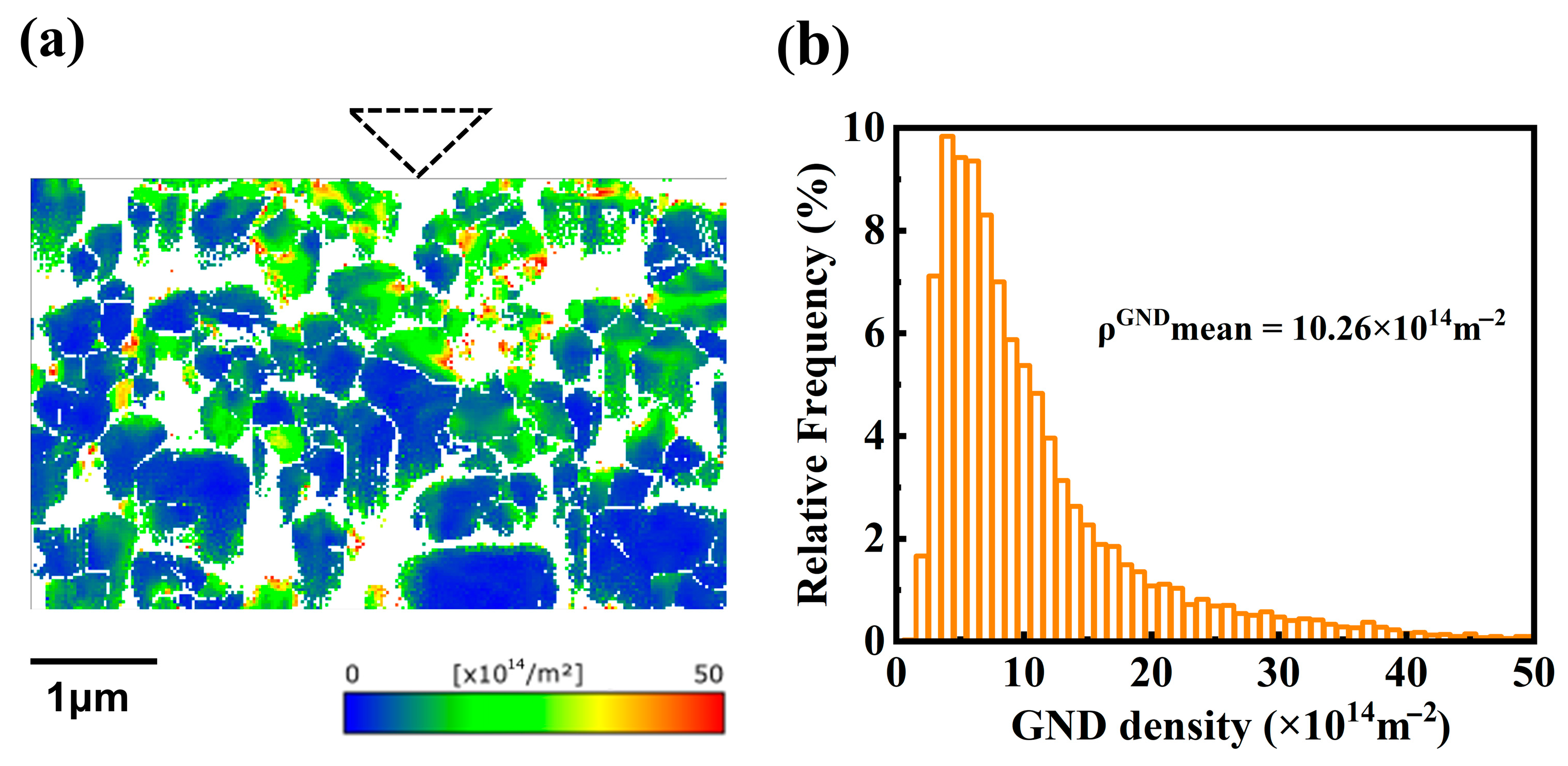
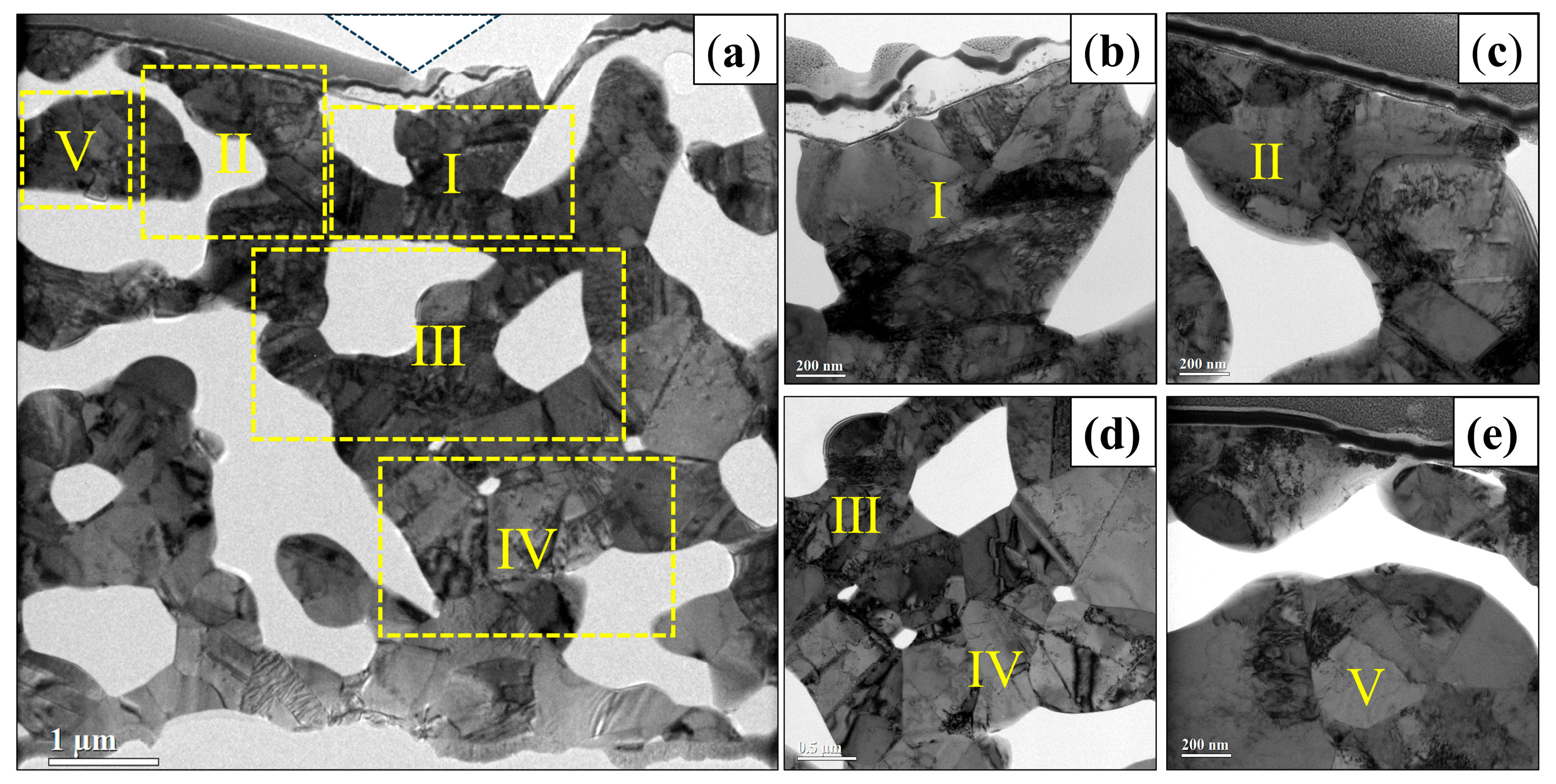
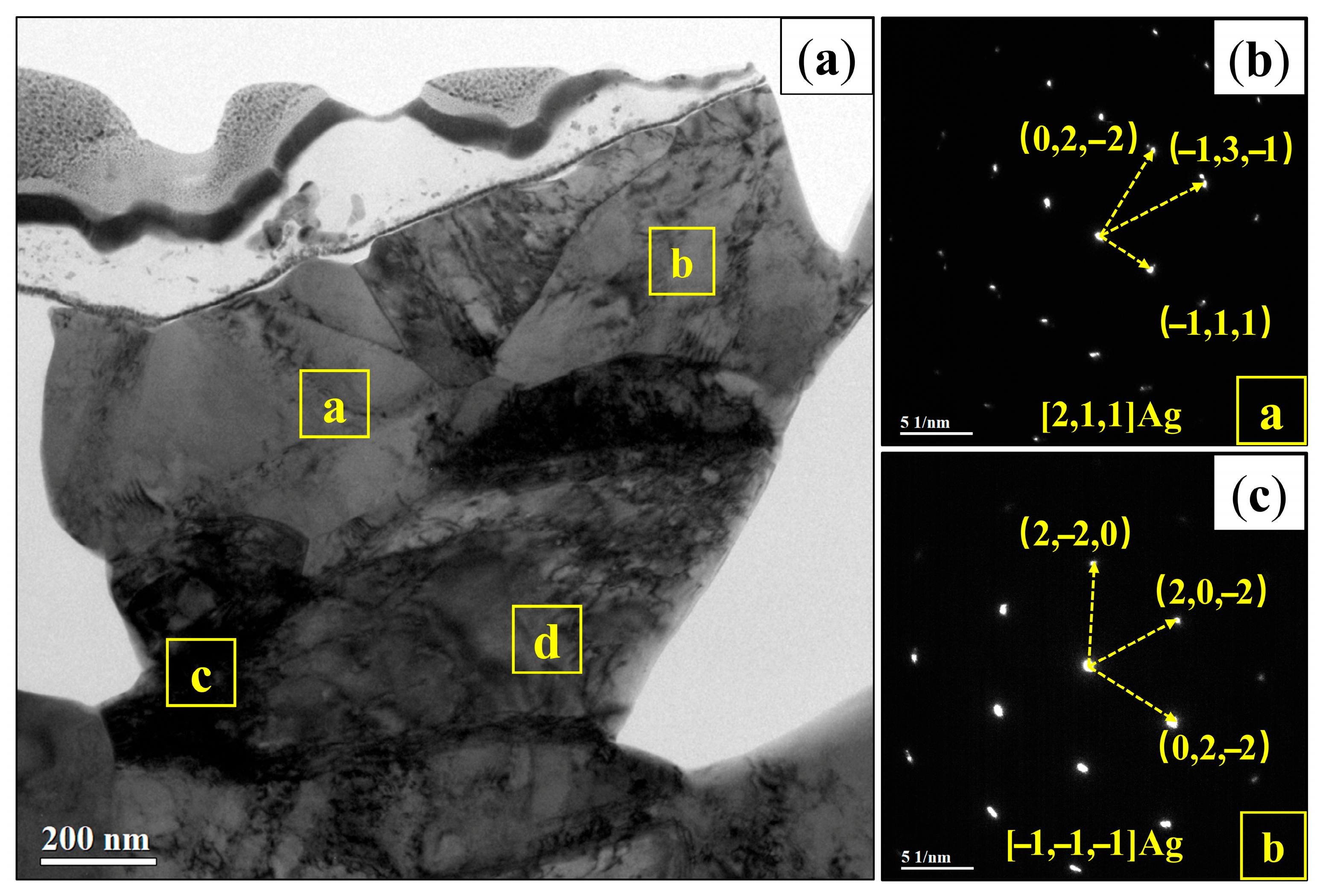
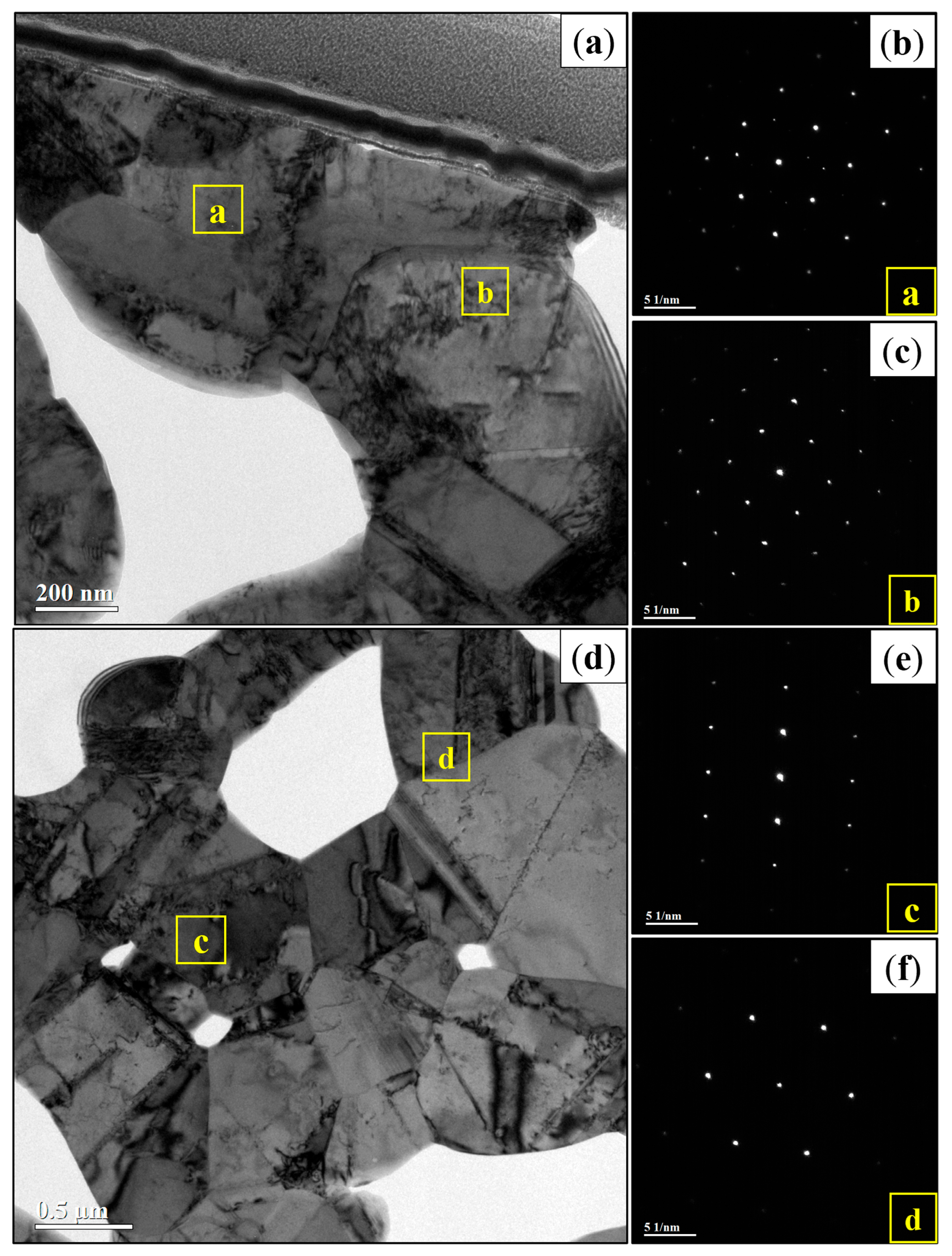
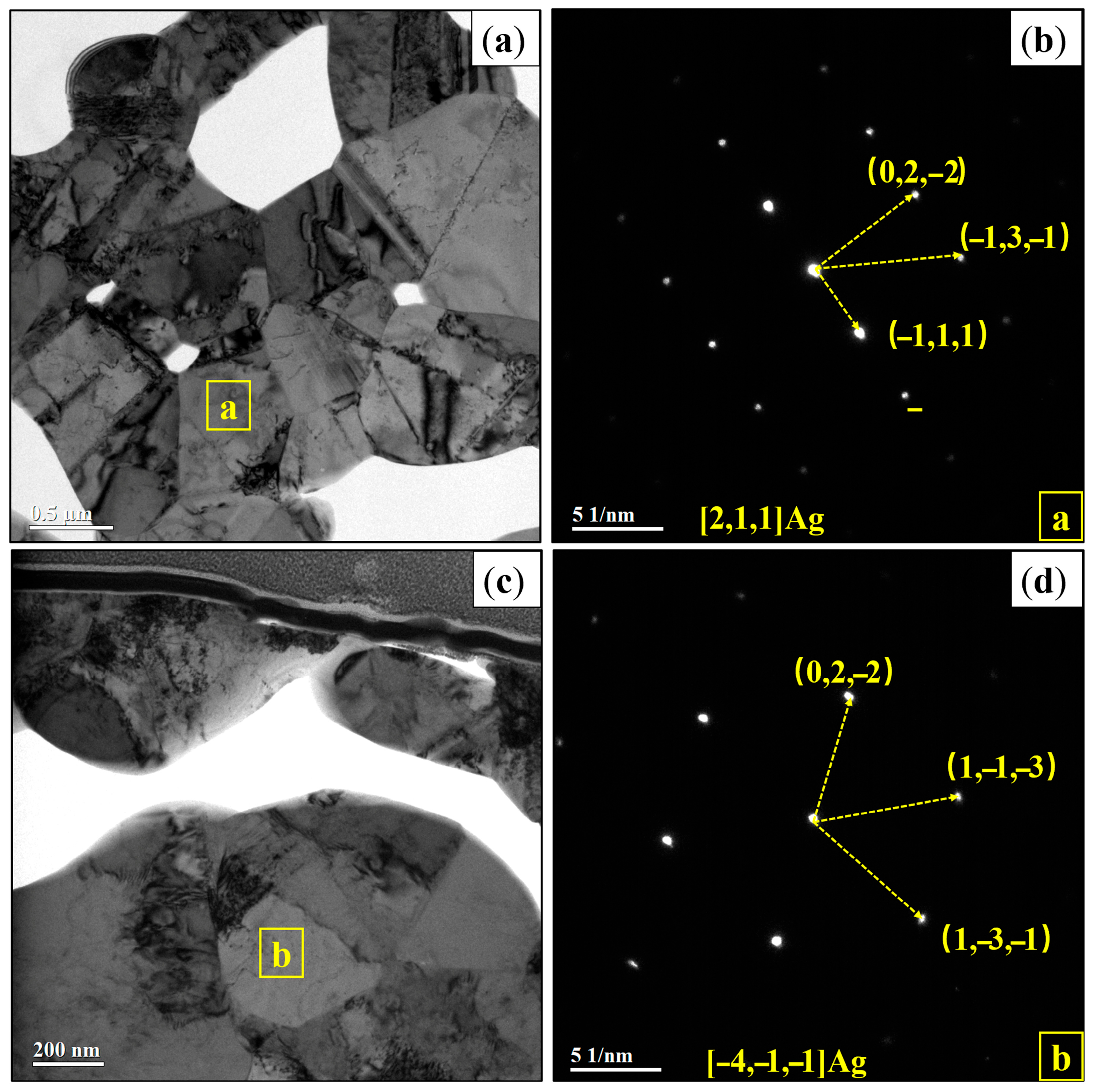
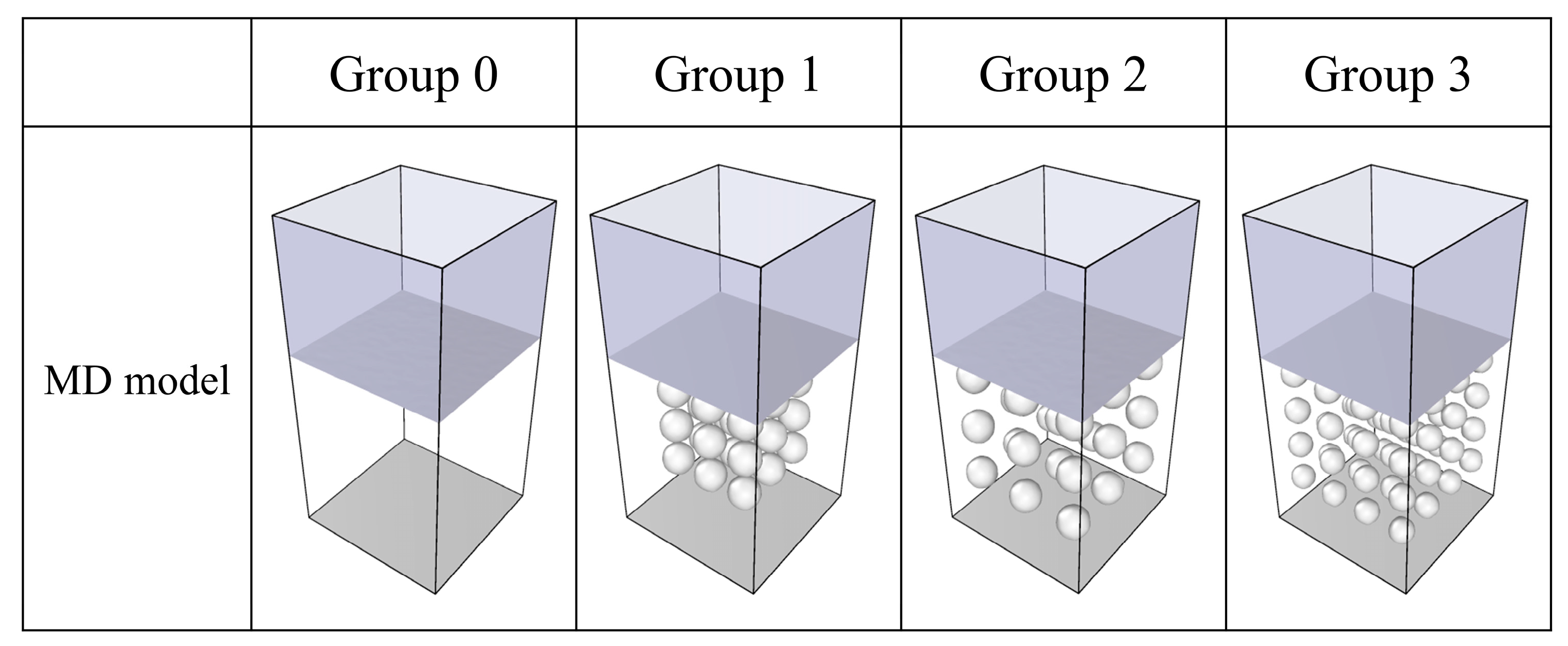

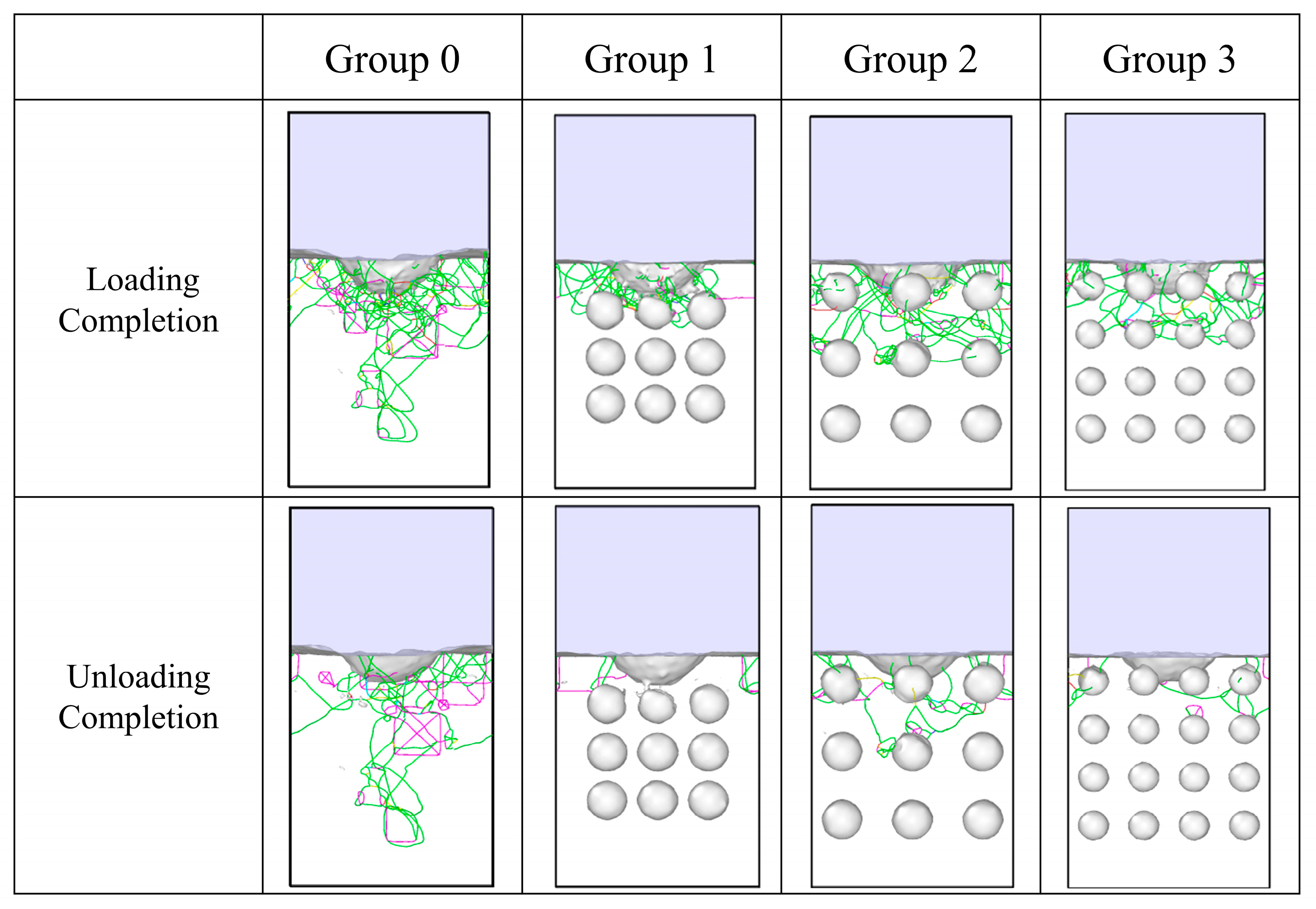
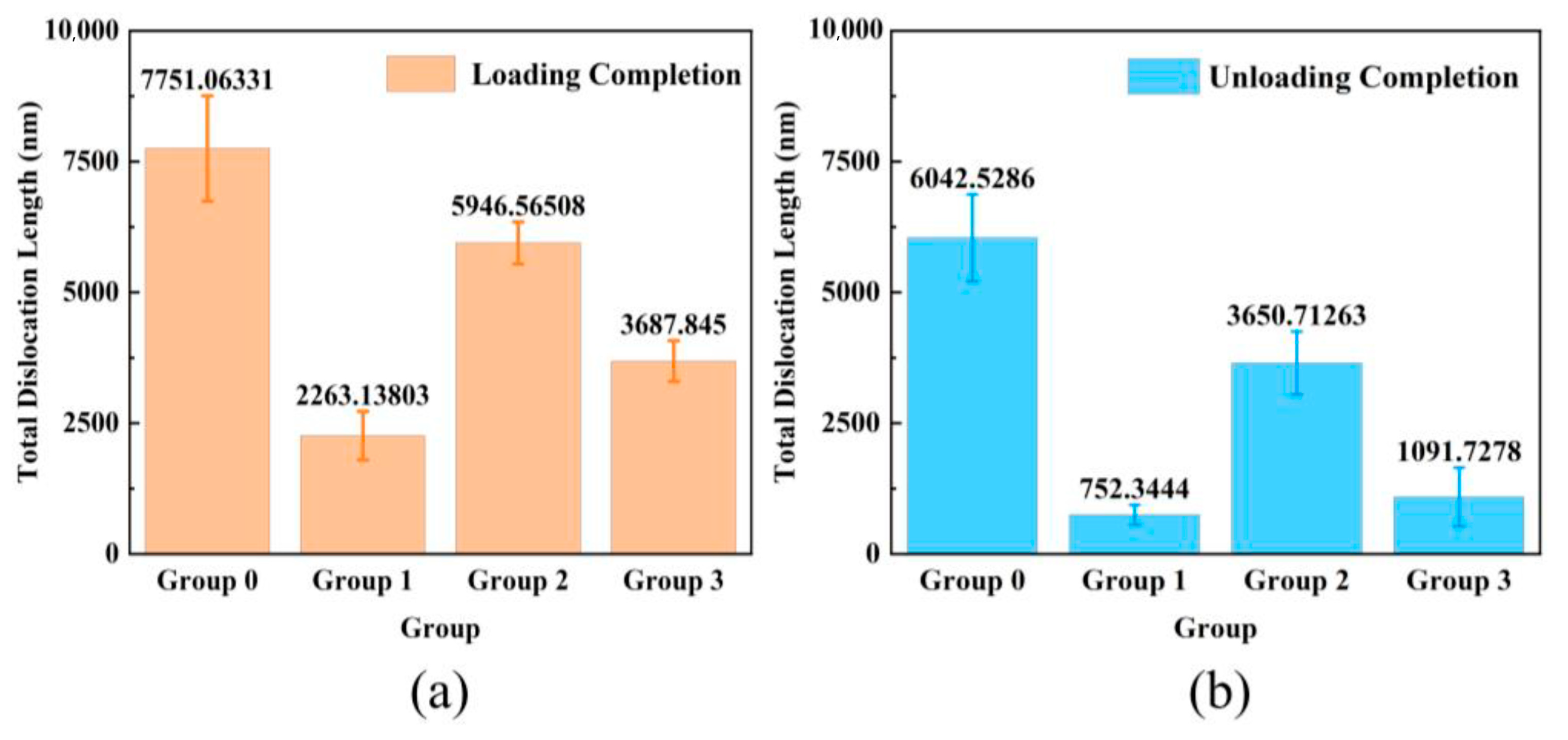
Disclaimer/Publisher’s Note: The statements, opinions and data contained in all publications are solely those of the individual author(s) and contributor(s) and not of MDPI and/or the editor(s). MDPI and/or the editor(s) disclaim responsibility for any injury to people or property resulting from any ideas, methods, instructions or products referred to in the content. |
© 2025 by the authors. Licensee MDPI, Basel, Switzerland. This article is an open access article distributed under the terms and conditions of the Creative Commons Attribution (CC BY) license (https://creativecommons.org/licenses/by/4.0/).
Share and Cite
Sun, Y.; Wang, X.; Chen, H.; Liu, P. Nanoindentation-Induced Deformation Mechanisms in Sintered Silver: A Multiscale Study Combining Experimental and Molecular Dynamics Simulations. Crystals 2025, 15, 620. https://doi.org/10.3390/cryst15070620
Sun Y, Wang X, Chen H, Liu P. Nanoindentation-Induced Deformation Mechanisms in Sintered Silver: A Multiscale Study Combining Experimental and Molecular Dynamics Simulations. Crystals. 2025; 15(7):620. https://doi.org/10.3390/cryst15070620
Chicago/Turabian StyleSun, Yiping, Xinyue Wang, Haixue Chen, and Pan Liu. 2025. "Nanoindentation-Induced Deformation Mechanisms in Sintered Silver: A Multiscale Study Combining Experimental and Molecular Dynamics Simulations" Crystals 15, no. 7: 620. https://doi.org/10.3390/cryst15070620
APA StyleSun, Y., Wang, X., Chen, H., & Liu, P. (2025). Nanoindentation-Induced Deformation Mechanisms in Sintered Silver: A Multiscale Study Combining Experimental and Molecular Dynamics Simulations. Crystals, 15(7), 620. https://doi.org/10.3390/cryst15070620





